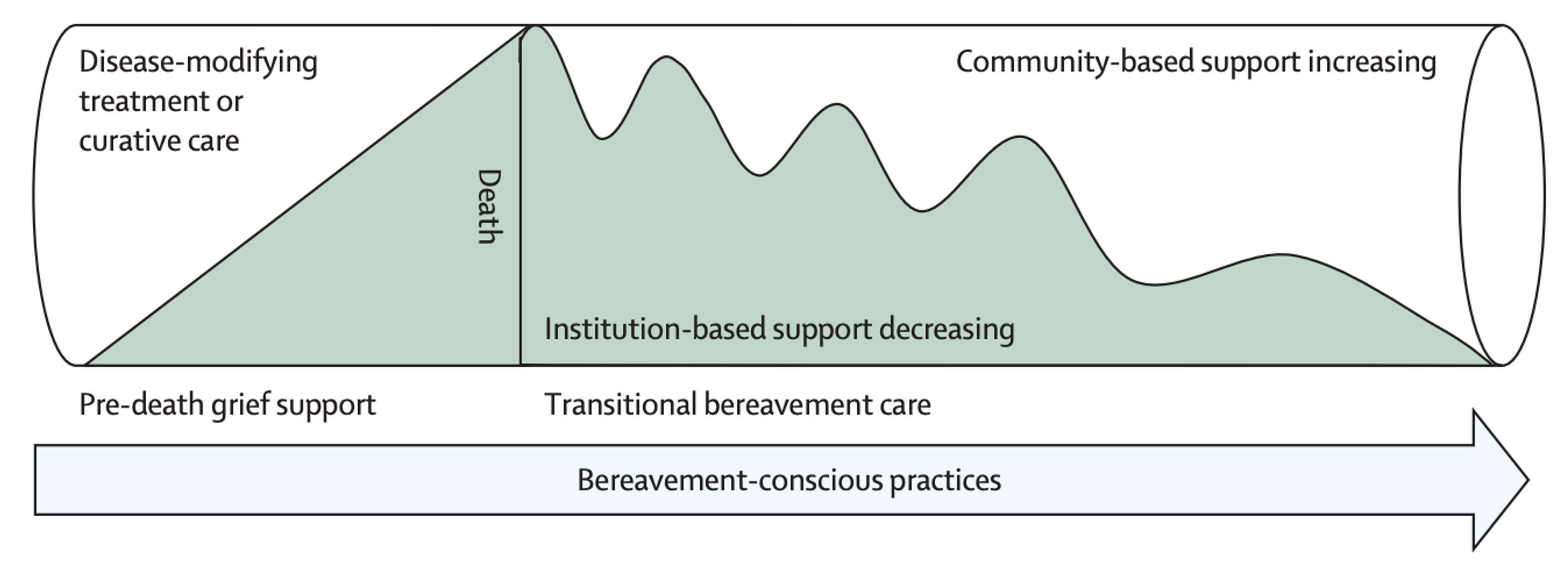La piedra angular del CABC es el Modelo de Atención de Duelo Transicional. Este modelo promueve la continuidad de la atención para la familia elegida por el paciente durante el duelo. También llama la atención sobre la responsabilidad que tienen los sistemas de salud de ayudar a los dolientes a hacer la transición de los recursos de duelo basados en instituciones a la atención en la comunidad, abogando por el uso de evaluaciones basadas en evidencia y apoyo en ambos entornos. El CABC se basa en la creencia de que generar apoyo en la comunidad y este tipo de atención de transición puede abordar la brecha entre los recursos naturalmente finitos que ofrecen los sistemas de salud y la atención más sostenible disponible dentro de la comunidad.
A continuación, se incluyen recursos adicionales que describen el modelo de atención de duelo de transición y cómo informa nuestro trabajo en el Centro para el avance de la atención de duelo.
Para obtener más información sobre este modelo desde un punto de vista de salud pública, busque la publicación de The Lancet aquí:
https://www.thelancet.com/journals/lanpub/article/PIIS2468-2667(24)00030-6/fulltext
Para obtener más información sobre este modelo y cómo informa nuestro trabajo en Sylvester Comprehensive Cancer Center, consulte nuestra publicación con University of Miami Miller School of Medicine News aquí:
https://news.med.miami.edu/sylvester-calls-for-bereavement-funding/
Para ver una visualización del modelo y los componentes recomendados de los apoyos institucionales y comunitarios, consulte a continuación:
 Figura: Conceptualización de la atención de duelo transicional. De “Invertir en la atención de duelo como una prioridad de salud pública”, por W.G. Lichtenthal, K.E. Roberts, L.A. Donovan, L.J. Breen, S.M. Aoun, S.R. Connor, W.E. Rosa, 2024, 1 de abril, The Lancet Public Health, 9(4), pp.e270-e274.
Figura: Conceptualización de la atención de duelo transicional. De “Invertir en la atención de duelo como una prioridad de salud pública”, por W.G. Lichtenthal, K.E. Roberts, L.A. Donovan, L.J. Breen, S.M. Aoun, S.R. Connor, W.E. Rosa, 2024, 1 de abril, The Lancet Public Health, 9(4), pp.e270-e274.
| Establecimiento de apoyos institucionales | Desarrollo de apoyos comunitarios | |
|---|---|---|
| Atención preventiva del duelo | Los equipos de atención médica participan en prácticas conscientes del duelo, conscientes del dolor previo a la muerte y el posible efecto de las experiencias del final de la vida en la familia en duelo y de la importancia de sus relaciones con la familia del paciente moribundo. | Las comunidades compasivas son conscientes de las necesidades emocionales y prácticas de la familia del paciente moribundo. |
| Apropiación de la atención del duelo | Las instituciones brindan servicios de duelo y cuentan con personal dedicado a educar a los médicos y al personal, realizar evaluaciones de riesgo de duelo, llegar a los dolientes personas, desarrollar recursos de duelo y brindar asesoramiento o apoyo para el duelo. | Se mantienen centros de atención al duelo en la comunidad y se identifican defensores de la atención al duelo para la atención universal del duelo dentro de las organizaciones relevantes (por ejemplo, lugar de trabajo, escuelas, instituciones religiosas o centros de atención para personas mayores) |
| Asignación de recursos para la atención al duelo | Se asignan recursos, incluido personal dedicado y financiado, para ofrecer alcance universal y recursos para todas las personas en duelo (por ejemplo, llamadas de condolencia, servicios conmemorativos, recursos educativos y basados en la web, y apoyo de pares y grupal) y para brindar apoyo específico a quienes lo necesitan. | Las partes interesadas en duelo brindan información a las instituciones, comunican necesidades y se relacionan con grupos de la comunidad para identificar barreras y facilitadores para el apoyo al duelo y para determinar los recursos necesarios, integrando identidades sociales interrelacionadas (por ejemplo, religión, etnia o clase) |
| Capacitación de los proveedores de apoyo | La educación sobre el cuidado del duelo se integra en los programas de capacitación de los trabajadores médicos y de la salud; las instituciones brindan educación continua sobre el cuidado del duelo a todo el personal, así como a especialistas dedicados al duelo. | Una fuerza laboral de especialistas en duelo capacitados en la comunidad que sean accesibles (por ejemplo, acepten seguros); educación comunitaria sobre cómo apoyar compasivamente a los dolientes y aumentar la alfabetización sobre el duelo. |
| Implementación de atención basada en evidencia | La atención del duelo se basa en evidencia; Hay fondos disponibles para la investigación para el desarrollo de evaluaciones, intervenciones y programas de capacitación eficaces para el duelo. | La investigación se diseña e implementa en asociación con los dolientes y las comunidades para crear conjuntamente las mejores prácticas para apoyar a los dolientes. |